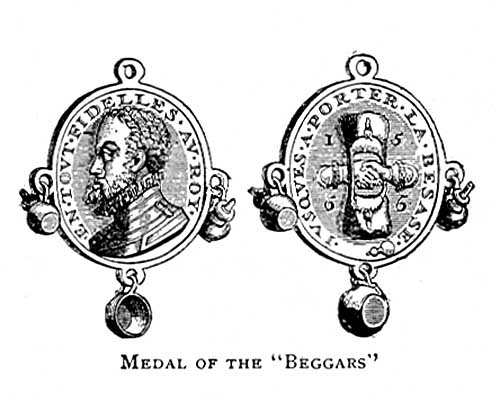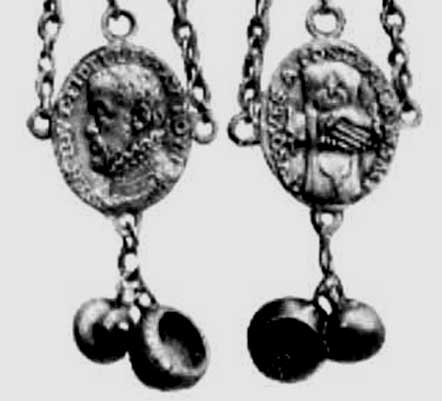Mutt was leafing through an old book from The Story of the Greatest Nations series, published 1901 by F.R. Niglutsch when he noticed a line drawing of a medal as clip art to fill out the page. The only identification was the caption MEDAL OF THE BEGGARS.


Bowls, flasks and badges were all symbols of the Sea Beggars during the Dutch Revolt. In April 1566 a group of several hundred noblemen presented a petition to Margaret of Parma, regent of the Netherlands, asking for greater tolerance in religious questions. But instead of being treated seriously they were ridiculed as 'gueux': beggars.
Taking the French epithet (bastardised into 'geuzen') as an honorary title, they adopted the beggar's insignia. The badge is the sign which cities gave those they permitted to beg. The wooden bowl and the pumpkin-shaped flask were the accessories of the indigent pilgrim.
Adorning the front of the medal, giving it the appearance of a heraldic symbol, is a portrait of King Philip II with the inscription en tout fideles au roy (faithful in every way to the king). On the reverse are two hands in a beggar's wallet, and, to continue the motto ironically: jusques a porter la besace (up to the wearing of the beggar's wallet) and the date 1565.
Jeff was able to add a little history to the story. "In the period 1550-1560 the Dutch Provinces were trying to gain their independence from the Spanish empire of King Philip II. Consequently many Dutch people, including noblemen were persecuted, because they committed treasonous acts against Spain.
They were Protestants that lived in the Netherlands and were hounded by the Spanish Inquisition, which often confiscated the properties and titles of those it convicted. The Spanish rulers used the Blood Council to try and convict those that they considered guilty of treason.
About this time, groups of people began wandering and started robbing and plundering. Often monasteries and clerical travelers were their targets. These roving bands came to be known as the wild beggars or forest beggars. For a while the Spanish army managed to suppress them, but in the latter half of the decade they resurfaced as the sea beggars.
The sea beggars were comprised of adventurers, pirates and patriots, fighting against the Spanish rule in the Dutch provinces. At sea they proved to be even more successful than on land, though not unbeatable.
For several years their bases of operation included the ports of Emden, on the coast of the Dutch Province, Friesland, La Rochelle, France and Dover, England. The sea beggars attacked vessels of almost any nation as well as fishing villages and towns on the coast of the Dutch Provinces."
This uprising was the beginning of the 80 year war for Netherlands independence from Spain. There is a museum in the Netherlands with a picture of the medal shown above.
As Mutt said,” Even in an old book, you can find an interesting story from only a picture of a medal." "But it takes the Internet to find the rest of the story."
Mutt and Jeff are active members of the Ft.Lauderdale Coin Club. Mutt can trace part of his family back six generations to a Dutch seaman who jumped ship in Gravesend, England. An old family legend, refers to the joke that there were pirates as ancestors in the family. "Maybe they were the sea beggars."